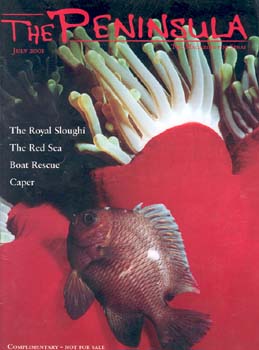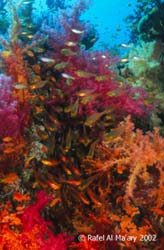 Well, it’s definitely a sea, but I’m not sure
quite how red it is. The Red Sea, or Al-bahr Al ahmar, is a narrow strip of water
separating Africa from Arabia, extending southwards from Suez for about 2000 km until the
Strait of Mandeb which connects with the Gulf of Aden, thence forward into the Arabian
Sea. At its widest point it’s 300 km across and splits into two at the northern end,
either side of the Sinai Peninsula, forming the shallow Straits of Suez on the west and
the rather deeper Gulf of Aquaba on the east. This Red Sea trough formed in two phases of
land motion. The first movement of Africa away from Arabia began 55 million years ago and
then the Gulf of Suez opened up 30 million years ago. The second movement was a mere 4
million years ago, creating the trough in the Gulf of Aquaba and the southern half of the
Red Sea which reaches depths of over 3000 metres. This movement continues even today at a
rate of 15mm a year, splitting us slowly apart from mainland.
Well, it’s definitely a sea, but I’m not sure
quite how red it is. The Red Sea, or Al-bahr Al ahmar, is a narrow strip of water
separating Africa from Arabia, extending southwards from Suez for about 2000 km until the
Strait of Mandeb which connects with the Gulf of Aden, thence forward into the Arabian
Sea. At its widest point it’s 300 km across and splits into two at the northern end,
either side of the Sinai Peninsula, forming the shallow Straits of Suez on the west and
the rather deeper Gulf of Aquaba on the east. This Red Sea trough formed in two phases of
land motion. The first movement of Africa away from Arabia began 55 million years ago and
then the Gulf of Suez opened up 30 million years ago. The second movement was a mere 4
million years ago, creating the trough in the Gulf of Aquaba and the southern half of the
Red Sea which reaches depths of over 3000 metres. This movement continues even today at a
rate of 15mm a year, splitting us slowly apart from mainland.
The Red Sea is one of the first mentioned large bodies of water in
recorded history, becoming very important to Egyptian maritime commerce around 2000 BC,
and was first charted in 1500 BC due to the fact that Queen Hatshepsut sailed along its
entire length. Later on, it was also used as a water route to India. In 1869, the
Frenchman Ferdinand de Lesseps oversaw the completion of the Suez Canal thus joining the
Mediterranean with The Red Sea. The rest, as they say, is history.
Now there aren’t a lot of rivers feeding The Red Sea, in fact
there aren’t any, but fortunately there’s an inflow of water driven up by the
north winds from the Gulf of Aden. The existing salty water, its high salinity caused
mostly by evaporation, sinks below the less dense incoming waters from the south and exits
over a sill at Bab el-Mandeb, resulting in a complete renewal of water every 20 years. In
the deepest portions of the Red Sea trough there are also pools of extremely saline water
with an average temperature of 60 degrees C. Heated from below, these pools become
unstable and disperse with the general circulation of water.
However, the reason for the recent popularity of the Red Sea,
apart from as a shipping route, is the profusion of life found just below its surface
which revolves around its coral reefs. These reefs can be divided into two distinct types,
those joined to the land masses and those sprouting from the depths like little islands.
All around the Sinai coast, almost unbroken stretches of coral reef jut out into the sea
from the base of the cliffs, virtually underwater shelves which stop suddenly and plunge
down to the depths giving rise to our famous wall dives such as those found at Ras
Mohamed. These walls often have fissures or caves, sometimes open at the top allowing the
sunlight to enter and cast shadows that render them ideal for underwater photography.
Out in the Gulf of Suez are many examples of the second type of
reef, sprouting upwards from the 40 metre deep, sandy-bottomed continental shelf and
reaching almost to the surface. These are sometimes lonely outcroppings, such as the
Lonely Mushroom and the Alternatives, or massive formations creating their own
sandy-bottomed lagoons such as Sha’ab Ali and Sha’ab Mahmoud. These reefs, which
are living creatures themselves, are also home to a myriad of life. The combination of
sunlight for photosynthesis and currents carrying waterborne food, encourage an amazing
growth and prosperity in this colourful underwater world. It’s somehow ironic that a
single celled animal has built a structure far exceeding in size and diversity anything
that man has yet created.
 Well, it’s definitely a sea, but I’m not sure
quite how red it is. The Red Sea, or Al-bahr Al ahmar, is a narrow strip of water
separating Africa from Arabia, extending southwards from Suez for about 2000 km until the
Strait of Mandeb which connects with the Gulf of Aden, thence forward into the Arabian
Sea. At its widest point it’s 300 km across and splits into two at the northern end,
either side of the Sinai Peninsula, forming the shallow Straits of Suez on the west and
the rather deeper Gulf of Aquaba on the east. This Red Sea trough formed in two phases of
land motion. The first movement of Africa away from Arabia began 55 million years ago and
then the Gulf of Suez opened up 30 million years ago. The second movement was a mere 4
million years ago, creating the trough in the Gulf of Aquaba and the southern half of the
Red Sea which reaches depths of over 3000 metres. This movement continues even today at a
rate of 15mm a year, splitting us slowly apart from mainland.
Well, it’s definitely a sea, but I’m not sure
quite how red it is. The Red Sea, or Al-bahr Al ahmar, is a narrow strip of water
separating Africa from Arabia, extending southwards from Suez for about 2000 km until the
Strait of Mandeb which connects with the Gulf of Aden, thence forward into the Arabian
Sea. At its widest point it’s 300 km across and splits into two at the northern end,
either side of the Sinai Peninsula, forming the shallow Straits of Suez on the west and
the rather deeper Gulf of Aquaba on the east. This Red Sea trough formed in two phases of
land motion. The first movement of Africa away from Arabia began 55 million years ago and
then the Gulf of Suez opened up 30 million years ago. The second movement was a mere 4
million years ago, creating the trough in the Gulf of Aquaba and the southern half of the
Red Sea which reaches depths of over 3000 metres. This movement continues even today at a
rate of 15mm a year, splitting us slowly apart from mainland.